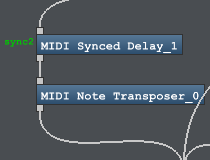

for instance, i started making music with trackers, and i still naturally feel that musical time moves from top to bottom, while people who are more ingrained in sheet music or a daw timeline might feel that it moves from left to right, just like a time bar in a audio file player.

there are many ways to experience and visualise the movement of time (both in your inner eye or with external images) – and that gradually affects your very experience of time. I would argue that our linear perception of time is very much not in our nature, but rather culturally constructed. The timeline needs not be represented or manipulable on the screen, it exists by the very nature of our perception I can definitely conjure a semblance of that curiosity and experimentation in the timeline, but for me it feels distinctly different to just play with sound as opposed to treating it in the businesslike construction facets of the daw. When I am working in a DAW I will definitely continue tinkering and working on sound design, but I am consciously building, making choices, arranging, and considering This in the context of That. You don’t have 30 tracks of random sounds to keep track of. There’s also (at least for the way I work) the somewhat liberating feeling that you’re not making any particular mess that is going to cause problems with your arrangement later. It is much easier to do certain things in a non-daw environment, like letting things loop asynchronously without having any awareness of bars/time signatures/duration or periodicity in general. I don’t know how things will develop, I tend to let things play out for longer than I ever would in an arrangement and record things that I am unlikely to use in order to just see where things go. Plenty of room for subjectivity here I guess! One of the reasons that non-daw environments (software or hardware) feel different to me is that I don’t feel rooted in decision-making. It works very well as a non-DAW environment. I have the beat/time grid and quantization functions fully disabled, etc. I use the clip launcher interface as my midi sequencer and audio record and playback environment. I never record to the timeline, actually. It’s CV and external audio routing features are very flexible and, if you elect to host VCV Rack as a VST in Bitwig, it extends these features to include as many audio interfaces, midi interfaces and CV interfaces as you would like to have.Īll this to say that I don’t use Bitwig as a DAW at all, in the traditional sense past hosting instruments and effects. I don’t want to break the flow here, but I feel like it is worth noting that a few DAWs, or maybe just Bitwig, can really shine in a “non-DAW” workflow.īitwig’s internal routing is fully modular: you can tap into audio from anywhere in a project and route it to any other point, you can make mixers at any point in a project, you can nest objects to any level and abstract modulation and parameters to the higher levels, and modulation works in a nearly fully modular way (and can be made fully modular with the DC audio device and Audio Rate modulation device), it features the Grid and Note Grid modular environments, etc.


 0 kommentar(er)
0 kommentar(er)
